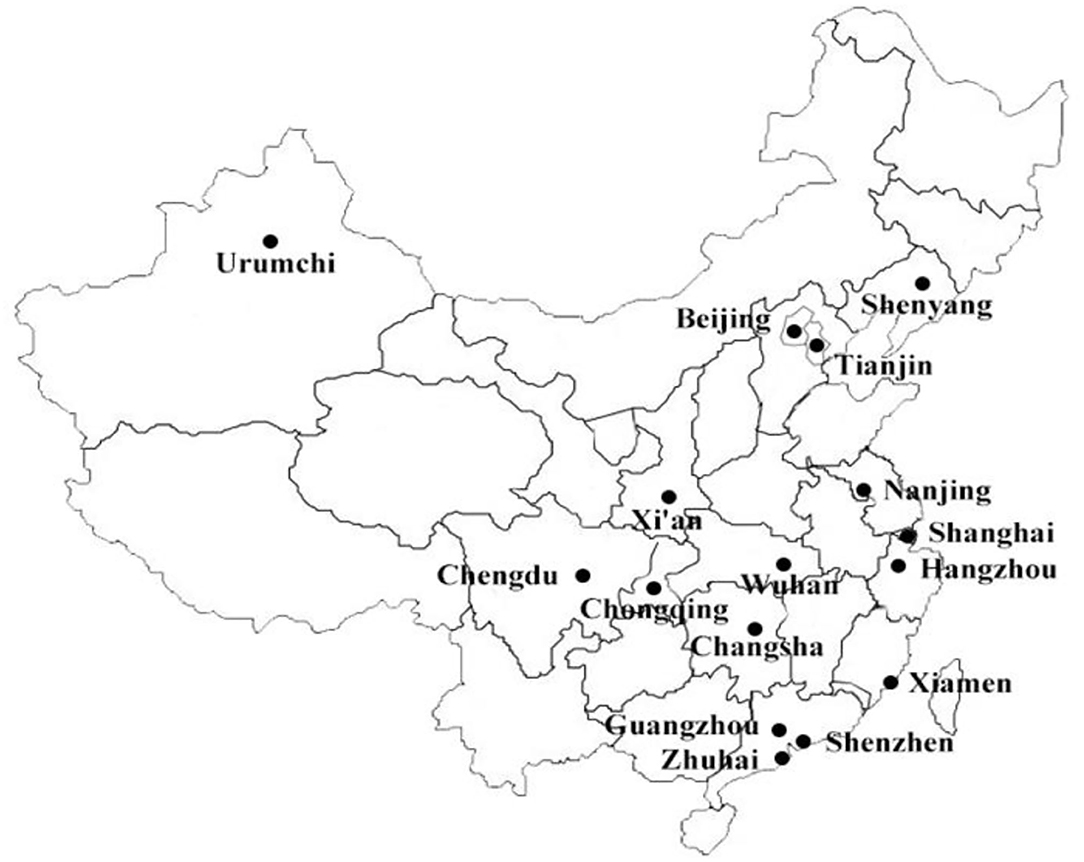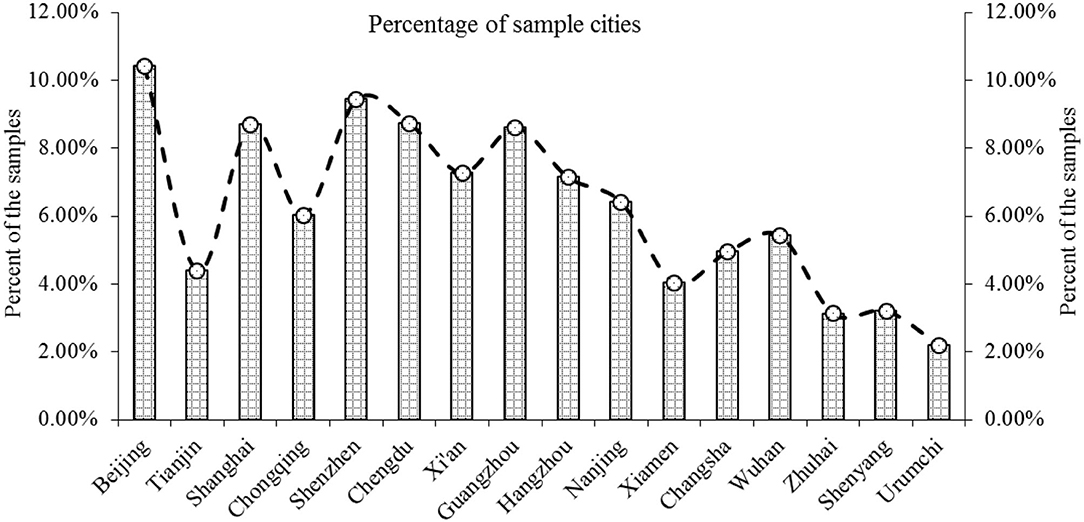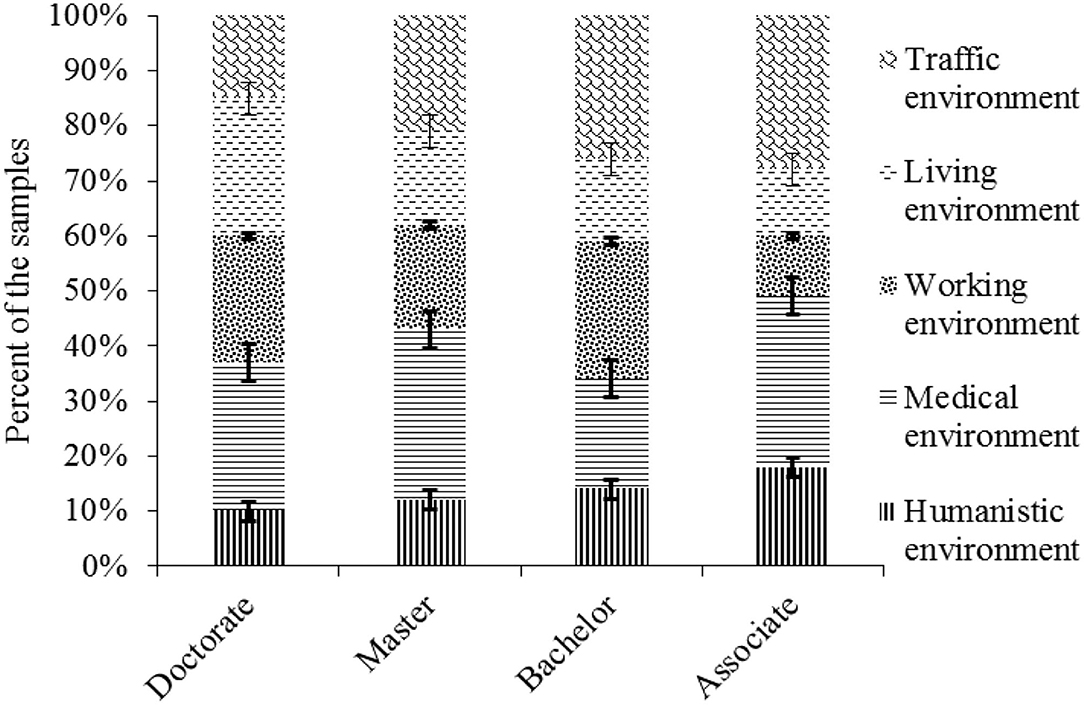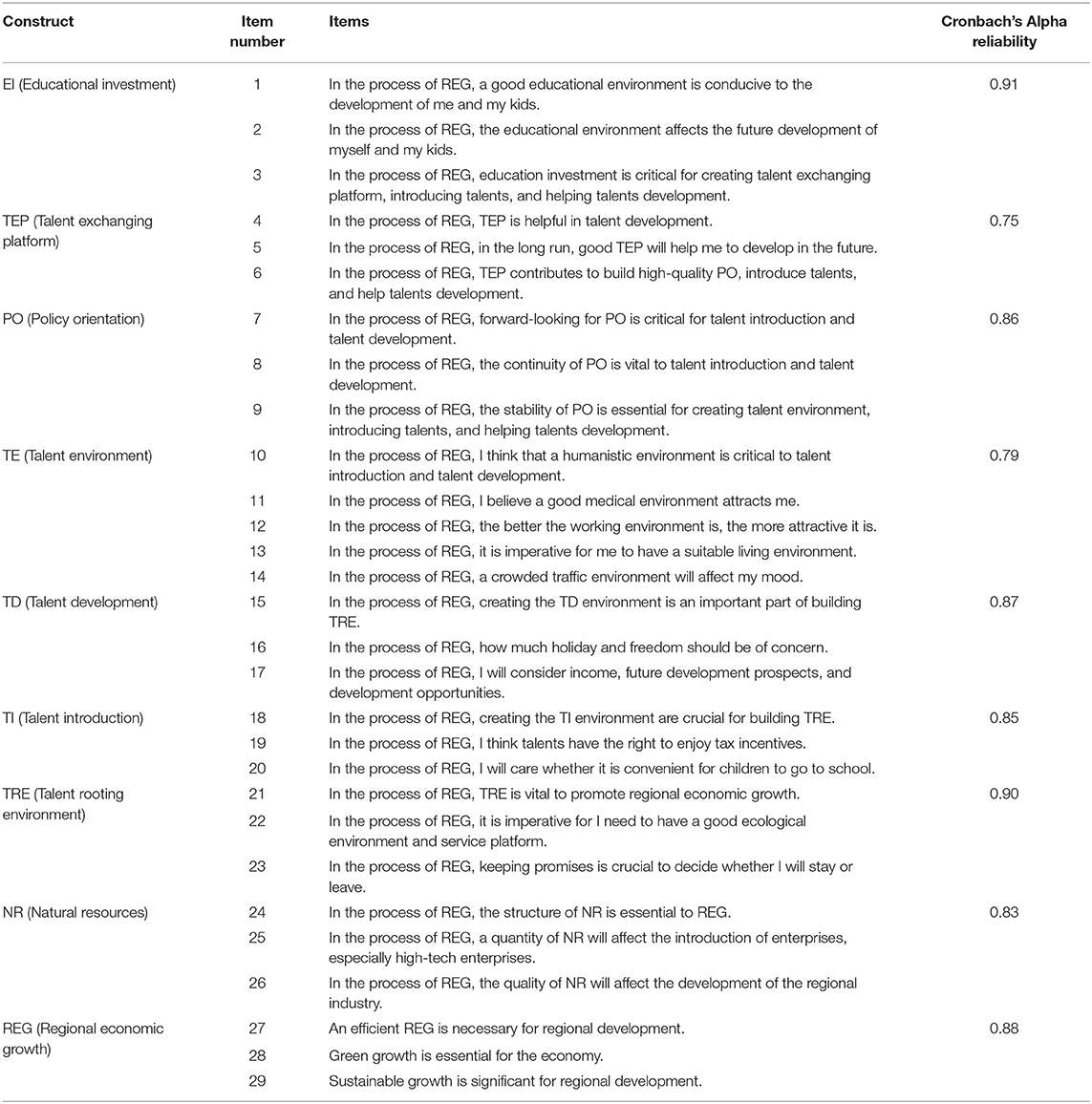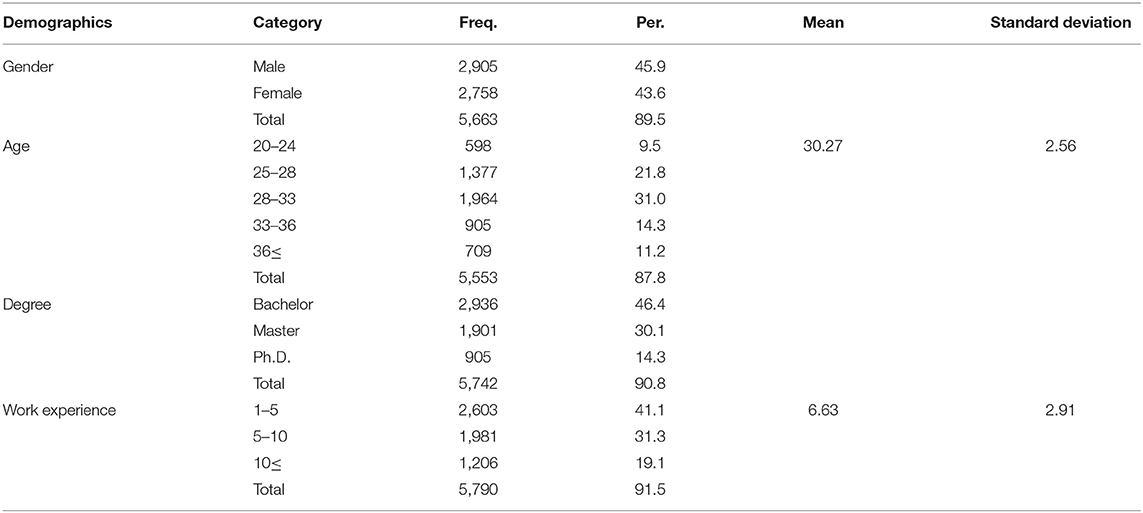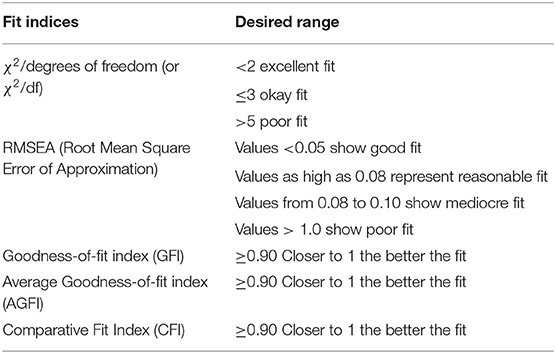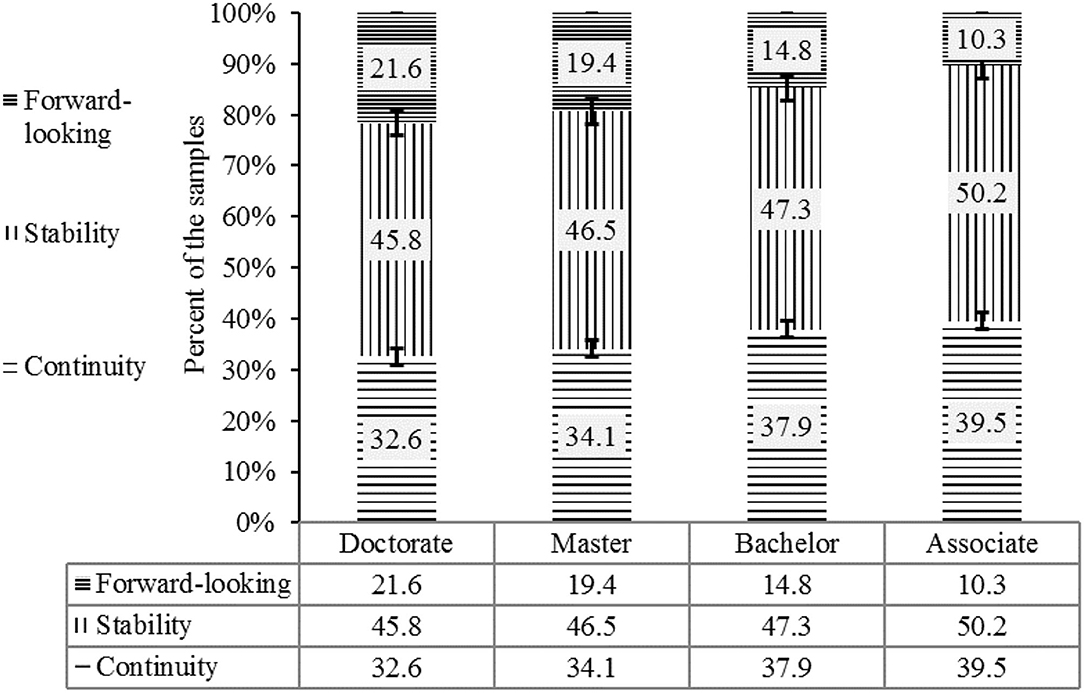- School of Management, Sichuan University of Science Engineering, Yibin, China
To understand the cognition of China's intellectual class on economic growth, this paper consulted the related documents and conducted questionnaires in China. A sample of 6,326 talented persons from 16 large and medium-sized cities was selected in a descriptive analysis study. The attitude of talents toward regional economic growth has been assessed by a conceptual pathway model of organizational environmental variables. The collected data is analyzed by the SPSS software package to establish a comprehensive framework model, which can quantitatively analyze the relationship between regional economic growth and its predictors. The relationship can be described as follows: YREG = 0.201XEI + 0.149XTEP + 0.217XPO + 0.148XTE + 0.480XNR + θ or YREG = 0.53XTRE + 0.480XNR + θ. The model suggested that regional economic growth was driven predominantly by talent rooting environment and natural resources. Compared with policy orientation, the talent exchanging platform was profound to pay more attention to the future development of talent. The model also demonstrated that increased education investment plays a pivotal role in China's intellectual class, which will directly or indirectly affect talent development, talent introduction, and the environment for talents to be rooted.
Introduction
Regional economy refers to the complex products in a particular region production produced by the interaction of internal factors and external conditions, reflecting the intrinsic rule of economic development and the link between connotation and extension. A regional economy takes a region as its scope and closely combines it with economic factors. Overall, there are two primary factors that influence regional economic growth (REG), namely talent rooting environment (TRE), and natural resources (NR; Liu, 2018). Therefore, TRE and NR investigations are essential for a series of strategic development planning and policy formulation for REG.
As one of the nucleus elements aiding the process of human survival, NR is deemed to be a fundamental driver of enterprise development, industrial distribution, and REG. Havranek et al. (2016) found that when considering potential publication bias and methodological heterogeneity, the overall support for the resource curse hypothesis is weak and the NR abundance affects REG. The economic transition literature (Teulon, 2015; Jović et al., 2016) demonstrated that NR has an essential influence on the development and transformation of the regional economy. Teulon (2015) indicated that the energy transition requires economic disruption, abandoning the mindset that environmental trouble is proportional to economic prosperity. Jović et al. (2016) argued that NR has a great influence on economic development, and thus NR rents should be considered as an object of investigation for economic development. Economists from around the world have proven the crucial role that is played in the economic growth by what they call the natural capital, or what we may be heralded as NR. Rodríguez et al. (2015) considered the relationship between physical and economical consumption of non-renewable NR using mining cost decomposition similar to that used in the literature on productivity and technological change. Wang et al. (2022) discussed the temporal and spatial pattern and evolution characteristics of the harmonized development of China's industrial economy, NR, and environmental quality by using the coupling coordination model. Jiang and Muhammad (2022) studied how to achieve strong decoupling between energy mix, energy intensity, energy efficiency, economic activity, and industry size and put forward some policies to efficiently promote sustainable development goals.
The principal to the economic development of a country or region, apart from NR, is its staffing capital, to put it simply, the human resources (Liu, 2018). Therefore, talent is the leading driving force for REG. Nevertheless, there is not much literature concerning the talent environment (TE). How to attract and retain talents? It depends entirely on TRE. Weng and McElroy (2010) suggested that elements of the macro human resource environment directly affect talent accumulation and regional attractiveness, and talent growth is partially mediated between the three levels of the human resource environment (economic environment, human resource policy environment, and enterprise human resource management) and regional attraction. Along similar lines, Rowland (2011) argued that a talent development strategy could help the company cultivate internal talent and put forward the survey results to support the view that this method may provide a long-term competitive advantage. Ariss et al. (2014) proposed that technological innovation, such as Taleo's talent market and LinkedIn, can apparently promote the ability of enterprises to quickly find talents around the world and more effectively match their supply and demand. Liu (2018) concluded that TRE is the fundamental driving force and decisive factor to promote REG.
TRE contributes to innovation, social development, and REG. Owing to the unpredictability of TRE, regional economic development needs guidance from relevant research achievements. Ideally, the study of economic expansion should have a set of inquisitions in TRE. Lee et al. (2015) showed the impact of globalization on economic growth related to China's authoritarian system. Li et al. (2019) demonstrated that enterprises would form passive interactive innovation and inhibit the impact of active innovation without the proper guidance of policies. Luo et al. (2022) found that financial technology innovation could effectively promote the total element productivity of the real enterprises, to some extent, and accelerate the transformation and upgrading of the substantial economy. Dang and Zhao (2020) concluded that multinational corporations could adopt an investment strategy that combines Chinese and host country cultures as a leading culture to reduce the cultural risk of foreign direct investment. Estrin et al. (2009) confirmed that transnational corporations could take an ASEAN-like approach, such as an investment strategy with Chinese culture as the dominant culture, to minimize cultural risk. Vos and Boonstra (2022) analyzed 85 cases published by companies operating in different cultures to develop strategies for implementation. Lewis and Heckman (2006) addressed the scientific principles of human resources and management by reviewing the issues with the definition of talent management and the lack of data to support the claims a large number of practitioners' claims. Batistič et al. (2021) focus on the direct and interactive effects of leadership attachment styles and committed human resource systems on two distinct stages of idea generation and implementation in an individual's innovation process. Kou et al. (2022) deemed that the role identity of frontline managers will guide their human resources implementation behaviors by combining human resources roles with self-concept. Piszczek and Berg (2020) established a conceptual model using attribution theory, which explains the cognitive process of work-family human resource practice and individual environment work-family fit perception. Silva et al. (2022) surveyed that the digital trend brought by industry 4.0 affects 13 different themes in the field of human resource management and promotes the trends and challenges of human resource management, labor force, and organization, which is based on a systematic literature review and content analysis of 93 articles in 75 journals.
Unfortunately, these investigations from NR and TRE have tended to address mainly the concentrated NR exploitation, NR utilization, industrial economy, enterprise transformation, corporate culture, HR management environment, etc., rather than major factors (presented in Figure 1) of regional economic development from the perspective of talent. Considering the analytical strengths of each method, a better method or approach is required to examine these factors. This study, based on previous research, established an integrated assessment model to investigate the nexus among NR, TRE, and REG and provided a brand-new perspective to study the cognition of China's intellectual class on REG. Meanwhile, this research specifies a quantitative reference for managers and policy-makers on how to create TRE.
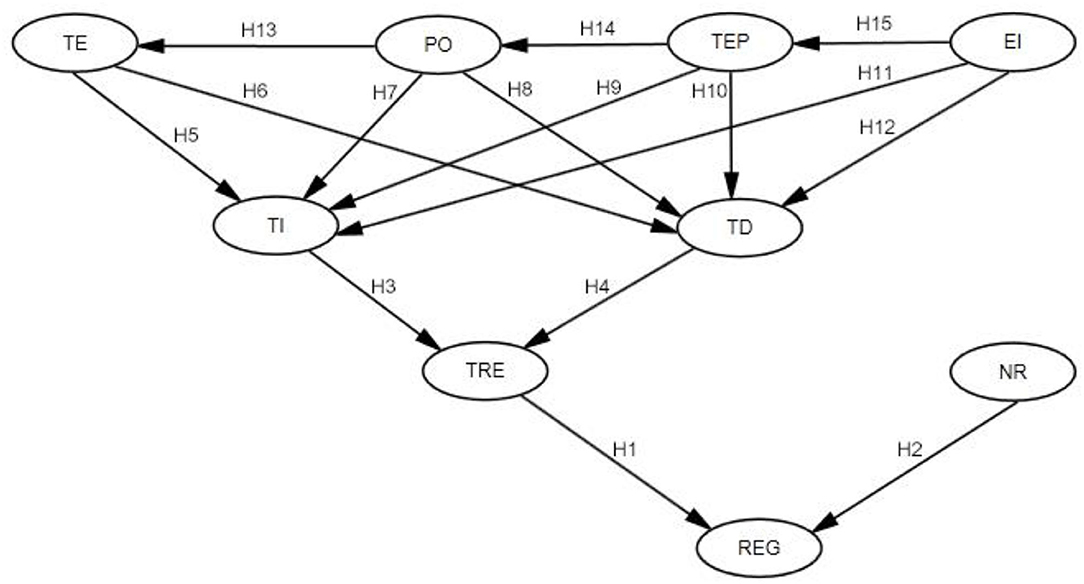
Figure 1. Hypotheses and the propounded conceptual path model of organizational context elements. EI, educational investment; TEP, talent exchanging platform; PO, policy orientation; TE, talent environment; TI, talent introduction; TD, talent development; TRE, talent rooting environment; NR, natural resources; REG, regional economic growth.
Hypotheses of the Study
TRE is defined as a regional environment to attract talent and make them ingrained. Regions attracted talents mainly through two interrelated mechanisms (Weng and McElroy, 2010; Liu, 2018). Conventional wisdom holds that places attract talents by matching them with employment and economic opportunities. Another perspective indicated that regions fascinated talents by providing a range of comfort TEs (Gottlieb, 1995). Such environments are regarded as pivotal to modern urban and as essential ingredients in attracting high-educated talents who have scarce resources and financial liquidity. Hypotheses and the propounded conceptual path model in this study are revealed in Figure 1.
Regional development needs to consider TRE to comprehend the role of talent in REG. Studies (Weng and McElroy, 2010; Feldstein, 2017; Liu, 2018) showed there was a battery of factors that contribute to REG, but the environment is crucial to attracting and keeping talents. Hence, TRE is one of the kernels driving forces for regional EG. Therefore, H1 has been put forth.
H1: TRE is positively associated with REG.
Economic activity is the activity of humans developing and utilizing NR to meet material and cultural needs. It takes NR as the material basis and labor object. Undoubtedly, any regional economic activity is based on NR because NR carrying capacity is the primary factor determining economic development. State's economic growth until today is hugely dependent on its NR (Rodríguez et al., 2015; Havranek et al., 2016; Qureshi et al., 2016; Nassani et al., 2019). The competitive advantage of the regional economy will merely thrive if its NR has been protected (Li et al., 2017). Consequently, the following hypotheses, H2 have been come up in this study.
H2: NR is positively linked to REG.
The introduction of high-level talents is a momentous project during regional economic development. Any practices and activities in TRE ought to be consistent with the talents introduction (TI) vision and long-run objectives of talents development (TD). Investing in TRE was a vital activity because it was the most stable and innovative organization rarely fails (Ibraiz and Randall, 2010; Rowland, 2011). TI and TD, the two essential factors in the TRE model, have been found to control talents' intention to stay specific region. In this study, TI and TD were drawn upon to capture these multiple dimensions of TRE. Accordingly, hypotheses with H3 and H4 have been presented as follows.
H3: TI is positively connected to TRE.
H4: TD is positively related to TRE.
TE impacts the TI of the region directly, as well as the TD of the region. It is the most critical production factor for the sustainable economic development of an area—in other words, talented personnel will bring about a competitive advantage to their owners. The key to attracting competent personnel was to create a suitable environment for them (Ingram, 2016). Optimal TE will help to enhance the competitiveness of regional development. Thus, hypotheses H5 and H6 have been come up in this study.
H5: TE is positively linked with TI.
H6: TE is positively correlated with TD.
Scarcely anyone seemed that poorly fashioned and uncertain policy orientation (PO) influenced TI and TD. PO uncertainty has increased in north-eastern China during the past four decades, leading to a brain drain in the northeast (Liu and Shen, 2014). Hence, H7 and H8 have been put forth in this study.
H7: PO is positively connected with TI.
H8: PO is positively correlated with TD.
Talent exchanging platform (TEP) has been generally determined based on literature review and previous empirical research (Pillay, 2011; Oketch et al., 2014), which is one of the core indices to evaluate the innovation of regional talents. TEP provides many chances for regional skills to study and communicate (Liu, 2018). Furthermore, the platform is also a necessary, critical, and practical approach to improving innovation ability. Therefore, the following hypotheses, H9 and H10, have been proposed.
H9: TEP is positively linked with TI.
H10: TEP is positively bound with TD.
To date, high-tech talents are critical and scarce for regional development. Managers should take into account that effective ways of luring and retaining talent are to establish an environment where people with special skills can develop (Hiltrop, 1999). One of the ways is education investment (EI) that can contribute to attracting visionaries, especially educated people, to stay in places with better educational environments. EI is not only beneficial for TI but also plays a crucial role for TD (Altbach, 2010). Consequently, hypotheses, H11 and H12, have been presented as follows.
H11: EI is positively affiliated with TI.
H12: EI is positively linked with TD.
Talents will flow to organizations that offer plenty of growth opportunities (Weng and McElroy, 2010; Liu, 2018). Keeping talents happy somewhere may become a non-issue if a good PO is provided to talent. Supposing that organizations are severe toward luring and keeping high-caliber talented persons, they need to look closely at whether the platform offered to skills is better than anywhere else. Thus, government or manager should provide visionary PO and set up a TEP for talents. Hence, hypotheses, H13 and H14, have been come up.
H13: PO is positively correlated with TE.
H14: TEP is positively kindred with PO.
EI can not only assist people in developing unique skills or knowledge sets in an excellent way (Ibraiz and Randall, 2010) but also change and improve a person's cognition. With the acceleration of life rhythm, however, predicting what skills people need is becoming increasingly difficult. Leaders who have accepted a well-educated generation should comprehend the importance of EI, which can help them effectively meet the demand for outstanding talents for TEP. Therefore, the following hypotheses, H15 has been put forth.
H15: EI is positively tied with TEP.
To discuss the impact of these factors on talent cultivation and REG, this research brought contextual elements into the technology acceptance model (Zhang et al., 2008; Abdekhoda et al., 2015; Liu, 2018), which is derived from the presumption that talents behavioral intention forecasts their willingness to root and cognition about the development of the regional economy. Figure 1 summarizes hypotheses and exhibits the propounded conceptual pathway model for AMOS and organizational contextual elements.
Methods
For investigating the elements of the propounded model, a questionnaire was designed and undergone several drafts before it was finally approved by experts (including scholars and practitioners) with seasoned experiences. The questionnaire was submitted to the talented person aged 22–45. Participants who had bachelor's, master's, or doctoral degree backgrounds were contacted and requested to fill out the questionnaire. Both male and female respondents from 16 main cities in China (see Figure 2) were included in the sample of this research. Owing to inaccessibility to the talent database, however, it was hardly probable for the researchers to touch with each, and every participant. Accordingly, taking the convenient sampling method collects the data by field investigation and questionnaire survey (such as email, QQ, and WeChat). The main factors impacting REG have been evaluated by the conceptual pathway model of organizational context variables and the technology acceptance model. As to statistical analysis of questionnaires, the SPSS AMOS software package has been used to process relevant data.
Data Collection and Sample
Data are gathered from diverse industries in 16 large and medium-sized cities, containing Beijing, Shenzhen, Tianjin, Chengdu, Shanghai, Chongqing, Xi'an, Guangzhou, Hangzhou, Nanjing, Xiamen, Changsha, Wuhan, Zhuhai, Shenyang, and Urumchi. Figure 3 shows the distribution of the survey samples in the cities.
A one-way analysis of variance was applied to test for differences in TRE among 16 cities. The main hypotheses of the study were tested using hierarchical regression analysis. In data processing, partial selection bias toward TRE was found in Figure 4.
Participants were only incorporated into the study when they were glad to respond to the researchers' requests. All respondents were assured that the information they provided would solely be applied for academic purposes and kept confidential. 7,153 valid questionnaires were returned from 8,000 surveys, but ultimately just 6,326 questionnaires can be used for research. These provide an 88.4% response rate, which is sufficient to support further study. Finally, sampling error was controlled with a 95% confidence level. The sample data that has been tested by Jarque–Bera (Thadewald and Büning, 2007; Kim, 2016, 2021) is normality distributed. Moreover, 6,995 people in 7,153 questionnaires believe that TRE and NR contribute to economic development by nearly 50%, respectively.
Measures
The kernel of the questionnaire was a range of items concerning issues that have been tendered in the documents to impact regional economic development (Navimipour and Zareie, 2015). The participants manifested their agreement or disagreement with Table 1 items using a 5-point Liker scale format (5 = strongly agree, 4 = agree, 3 = neutral, 2 = disagree, and 1 = strongly disagree). Nine variables were measured: five primary latent variable variables (TE, PO, TEP, EI, and NR), three intermediate latent variables (TI, TD, and TRE), and the final latent variable REG.
Reliability Analysis
The structural equation model (SEM) analysis procedure is applied in two stages derived from the related literature. The first phase contains performing the reliability analysis and confirmatory factor analysis specific to dimensions and items (Navimipour and Zareie, 2015). Although previous studies (Mohsen and Reg, 2011) referred to quite rational Alpha reliability for the measurements used in this research, validation was essential before carrying out the tests for the hypotheses of this research. Cronbach's Alpha reliability analyses were performed in SPSS. The results of the reliability analyses are shown in Table 1.
Table 1 validates the assertion of previous studies (Weng and McElroy, 2010; Liu, 2018) concerning the reliability of talent introduction and TRE. All the measures used in the current research presupposed higher Cronbach's Alpha reliability values (i.e., all these values are over 0.60), which was the recommended threshold for the reliability and acceptability of Cronbach's alpha (Pallant, 2013). Consequently, all the variables were highly reliable for the current research and evaluated the hypotheses concerning REG, confirmatory factor analysis (CFA), and SEM analysis in subsequent sections.
Results
Based on regression analysis of questionnaires, the results can obtain on the main factors affecting TRE and REG and the relationships among these factors.
Correlation and Validation
Demographic information of the research participants (in Table 2) manifests the mean and standard deviation for the demographic variables. The table displays that most of the respondents (54.1%) were female. The average age of survey respondents was 30.27 years, with 31% of participants aged 28–33. About 90.8% of the survey objects have university degrees. The data also demonstrated the mean year of 6.63 for the participants' work experience, while less than half (41.1%) had 1–5 years of working experience.
According to the findings of the investigation indicated in Table 3, there was a positive and remarkable correlation between the technology acceptance model variables (i.e., REG, NR, and TRE). This table exhibits a positive and remarkable correlation separately between TRE and TI, between TRE and TD, between TI and TE, between TI and PO, between TD and PO, between TD and EI, and between EI and TEP, between PO and TEP, between PO and TE. Moreover, it was also found that there is no significant correlation separately between TE and TD, between TEP and TI, and between EI and TI.
The effectiveness and feasibility of the propounded model are validated with various fitness measures. Standard values of fitting indexes stated by Byrne (2010) and analysis values acquired from the test have been listed in Tables 4, 5, respectively. The reason why SEM is advocated is that it expands the interpretive competence and statistical efficiency for model testing within a single integrated approach. Due to the sensitiveness of chi-squared statistics to sample capacity, the normed fit index (NFI), the root-mean-square error of approximation (RMSEA), and the comparative fit index (CFI) were used for evaluating model fit (Bentler and Bonette, 1980). Both the NFI and CFI with values over 0.80's evince an acceptable fit, whereas those exceeding 0.90 manifest an excellent fit. The RMSEA with values underneath 0.1 represent mediocre fit, values between 0.08 and 0.05 indicating responsible fit, and those lower than 0.05 signifying a close fit to the approximation of population (Byrne, 2010).
The goodness-of-fit (GFI) statistics are indicated in Table 5. The fitting indexes AGFI and GFI are both within the required range (i.e., 0.943 and 0.932 separately). Since RMSEA values of ~0.05 or smaller would clearly state the tight fit of the model, values of 0.08 or less would denote a rational error in the approximation. The Chi-square value is approved as well, the value of χ2/df is comparative ideal, and the RMSEA value is relatively small as it should be. CFI and NFI were considered and appeared to be advantageous. As the values of all fitness parameter indices are well within a permissible range, it can be signified that PO has an essential status in the process of TI and TD and that TRE and NR play essential roles in the process of REG.
Hypothesis Testing Result
Figure 5 presents the pathway diagram developed by IBM SPSS Amos software, illustrating the hypothesized relationships among latent structures. The values over the arrows signify the relevant normalized regression weights were derived after the execution of SEM analysis. The ratiocination here is on the ground of the path estimated values.
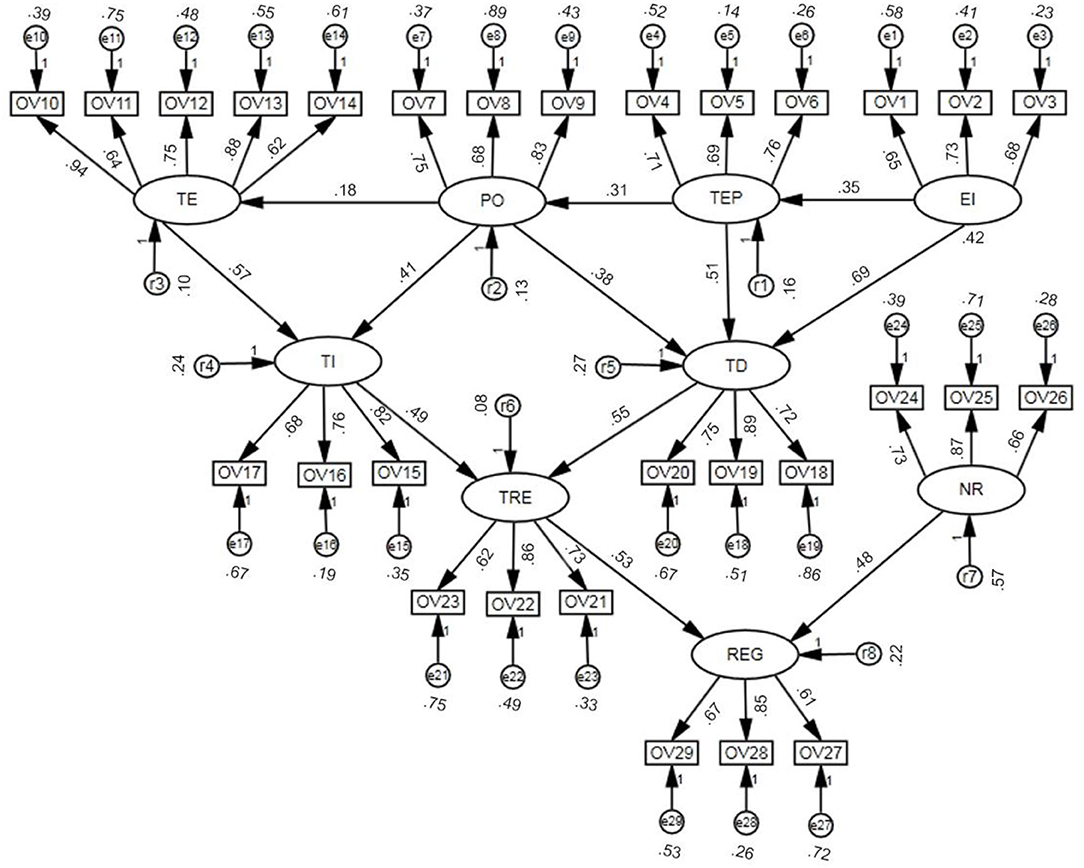
Figure 5. The standardized estimation results from the structural equation model. OV, observation variable; e, error; R, residuals. The values over the arrows manifest relevant normalized regression weights obtained after performing SEM analysis. The inferences drawn here are derived from the pathway estimate values.
Concerning the standardized beta coefficients of TRE and REG (β = 0.528, p = 0.001), dropping a hint about the connection between TRE and REG, H1 was backed. Then, it was observed that NR positively affected REG (β = 0.480 with p = 0.001), which upholds H2. These findings are similar to the results of the research conducted by Liu (2018), reporting that TRE and NR have a positive and pronounced impact on the growth of China's economy. As respects the link between TI and TRE, the findings indicated that TI had a positive and conspicuous effect on TRE (β = 0.489, p = 0.001). Hence, H3 was supported. Furthermore, the research results (β = 0.548, p = 0.001) manifested a positive and remarkable association between TD and TRE, supporting H4 and stating clearly that TD is positively bound up with TRE. Regarding the association between TE and TI, the discovery was favorable (β = 0.572, p = 0.001) and supported H5. To the correlation between PO and TI, the discoveries demonstrated that PO had a positive and prominent impact on TI (β = 0.411, p = 0.001). Consequently, H7 was supported. Also, survey results (β = 0.384, p = 0.001) insinuated a positive and noteworthy connection between PO and TD, propping H8 and implying that PO is positively connected with TD. Similarly, the findings (β = 0.512, p = 0.001), (β = 0.694, p = 0.001), (β = 0.181, p = 0.001), (β = 0.309, p = 0.001), and (β = 0.353, p = 0.001), show that H10, H12, H13, H14, and H15 were supported, respectively. As shown in Table 3 and Figure 5, concerning the relationships respectively between TE and TD, between TEP and TI, and between EI and TI, unexpectedly, the findings suggested there were no remarkable correlations separately between TE and TD, between TEP and TI, between EI and TI. Consequently, H6, H9, and H11 were not supported in this study.
Consistent with Weng and McElroy's (2010) finding, EI and TI, the two neutral variables, lead to more favorable parameter estimates of the TRE variables. Therefore, the model results based on our interpretation and discussion suggest talent is one of the crucial factors for REG, but not the only factor. The TRE that includes EI, TEP, PO, and TE is the critical node to attract and retain talents. Moreover, how TI and TD can play pivotal roles as mediators through ongoing consultation with TEP and PO, and how this applies the TRE standards that govern the utilization of such innovations with considerable flexibility. Identifying the determinants of REG makes measuring the resilience of the TRE and identifying the main priorities possible.
SEM and Evaluation Criteria
The measurement model as a part of SEM is recognized as a confirmatory factor analysis model, which examines the connection between the latent and observed variables. Universally, it is composed of two equations, which differentiate the association between the exogenous latent variables and exogenous observed variables, endogenous latent variables, and endogenous observed variables (Chou and Bentler, 1995). They can be represented by the equation as follows:
Where X = p × 1 is a vector of exogenous observed variables, Y = q × 1 is a vector of endogenous observed variables, ξ = m × 1 is a vector of exogenous latent variables, η = n × 1 is a vector of endogenous latent variables, Λx = p× m is a matrix, also known as factor loading matrix of exogenous latent variables, Λy = q× n is a matrix, described as factor loading matrix on endogenous latent variables, δ = p× 1 is a vector of measurement error, ε = q× 1 is a vector of measurement error, δ and ε denote the part that cannot be expounded by latent variables.
CFA is a particular case of the SEM, also called the covariance structure. By analyzing moment structures, the equations of a measured model can be obtained from Figure 5.
As shown in Equations (3–11), the normalized estimated loadings were between 0.60 and 0.95 to support convergent validity. Consequently, the design of the sample is reasonable and feasible. The structural model is described as a causal model. It mainly explicates the relationship between the latent variables (Chou and Bentler, 1995; Sohn and Moon, 2003; Evermann and Tate, 2016), which can be expressed by an equation like this:
Where η is the vector of endogenous latent variables, ξ is the vector of exogenous latent variables, β is the connection between endogenous latent variables, Γ is the value of exogenous latent variables on endogenous latent variables, ζ is the measurement error in the structural equation model, indicating the part that the model cannot be elucidated. The following structure model equations can be obtained from Figure 5.
Considering Equations (13–16), the structural equation for REG was proposed as follows:
Where YREG is the REG, XEI is the variable of EI, XTEP is the variable of TEP, XPO is the variable of PO, XTE is the variable of TE, XNR is the variable of NR, and θ is the corrected value. Using the model to predict REG described in the above equation, it is clear that TRE will be more effective if they were targeted at fostering TEP, TE, especially EI and PO.
Using the structure model to predict intention described in Equation (13), it was clear that the growth of the regional economy depended mainly on TRE and NR, and TRE had played a significant role. TRE consisted of TI and TD. From the regression coefficient of Equation (14), it can be seen that talented people paid more attention to their future development while they considered whether to stay in one place. Namely, TD was more critical than TI. According to Equation (15), PO and TE were critical two factors during the process of TI, with PO having a positive effect on TE. Similarly, TD was made up of three parts: EI, PO, and TEP. Equation (16) showed that EI had a positive effect on TEP and TEP had a positive effect on PO. As can be seen from Equation (17), REG relied strongly on EI, TEP, PO, TE, and NR. Results of the studies (Weng and McElroy, 2010; Li et al., 2017) indicated that the insignificancy of most of the independent variables as a group signifies that there is no short-run connection between variables, and negative and remarkable error correction means that there is a long-term association between variables. Therefore, it is found that there is a long-run causality between REG and nine factors.
Based on the analysis of competitiveness reports (Samans et al., 2017; Liu, 2018; Pan et al., 2019) and relevant data, such as the REG rate of the United States, People's Republic of China National Bureau of statistics in recent years, and research results of domestic and foreign-related institutions, the evaluative criteria can be constructed for the green development pattern of the regional economy. The evaluative development pattern is described as follows:
where RREG is the rate of increase or decrease on REG, YREG_after is the REG of the next 5 years, and YREG_previous is the REG of the last 5 years. When the growth rate from Table 6 is >2% in an intermediate stage of development, it represents that economic development has entered the initial phase of the green development pattern of the regional economy.
Discussion
This study confirms the view of the Chinese intellectual class that improving EI helps to enhance managers' awareness so that they can build TEP, build high-quality PO, and create good TE, which is a potential driver of TI and TD. In the eyes of China's knowledge class, talents attach importance to PO and TE at the beginning. When they entered the workforce, TEP and PO were valued more by talented persons. The cognition of policy orientation (PO) varies among different educated ranks. Regardless of the layer of Chinese intellectuals, however, the stability of PO is highly concern. It can be seen from Figure 6 that the higher educated values more emphasis on forward-looking policies. In contrast, those with low and middle education appreciate the continuity of the policy. The above is determined by the needs of Chinese intellectuals at different levels. Therefore, PO is vital to the introduction and development of talents, which can be confirmed from the results in Figure 5. Compared with the PO, the TEP is more profound and pays more attention to the future development of talents. The model shows that an increasing EI plays a crucial role in China's intellectual class, which will directly or indirectly affect the public policy environment for talent cultivation, talent introduction, and talent development.
“New officials ignore old accounts” has existed in China since ancient times, making the government no credibility. However, all the so-called “old accounts” left behind and shelved are not conducive to the current development. The easiest and most convenient way for a new official to take office is to ignore them. Chinese officials change frequently and the PO fluctuates to be unstable under the unique system, which often leaves talents at a loss. This is why students from good Chinese universities go overseas, and many never want to go back to their motherland anymore. To solve the current problem of “new officials ignoring old accounts,” the government should make efforts in the TEP and EI. Meanwhile, the issue of government PO should be solved. The continuity, stability, foresight, and predictability of the policy guidance of each government leading group are directly related to China's development in the next decade, decades, or even hundreds of years. For example, the PX project in Pengzhou, Chengdu, is due to the problem of government guidance, which directly affects TRE and the future development of Chengdu.
Conclusion and Suggestions
This study has adopted methods from three categories of empirical methods—cross-sectional, panel data, and time-series approaches to study the cognition of China's intellectual class on regional economic growth (REG). It is the first literature that reports the analysis of talent rooting environment on economic growth by structural equation modeling (SEM). An integrative framework model was derived by using regression analysis, and the relevant standards were constructed for the green development model of the regional economies. Empirical results support Liu's (2018) viewpoint that REG is mainly driven by NR and TRE. It also implies that REG is driven by EI, TEP, PO, etc., whereas TRE is the core factor. TRE, to most organizations today, is worldwide, complicated, and highly competitive, which is probable to remain in the future (Beechler and Woodward, 2009; Ibraiz and Randall, 2010).
Talents are the core to the success of the transformation and upgrading of resource-based industrial structures. Talent quality determines the direction of the industrial chain, ecological chain, and value chain. To promote the transformation, upgrading, and development of the regional resource-based industries, we must rely on high-quality talents. Breaking the barriers of the regional economic system and solving the demand problems concerned by talents can make excellent talents gather. Facing the challenges during the regional development process, the following recommendations might be put forward. Based on the global vision, firstly, the talent system should be established in line with international standards. Providing sustainable growth of the regional economy in an uncertain global environment is implemented by forming innovative evolving strategies of TRE. Innovations in TRE, in particular, create the basis for sustainable development and transformations of REG. Secondly, the management and human resources departments should further optimize management structure, build a livable environment and strengthen regional soft power to attract and ensure that people can fully play to their aptitudes. Most important is to provide excellent TEP for talent innovation and keep PO consistent, timely, and forward-looking.
This work is limited to a survey of the Chinese intellectual class to examine REG. Given China's unique national conditions and institutional system, the Chinese intellectuals have different perceptions of REG. Owing to the complexity and instability of China's development, the impact of TRE on REG varies according to other factors. Therefore, the conclusions and applications of this paper have certain limitations. However, the findings of this study make a significant contribution to people from other countries to understand contemporary Chinese intellectuals' views on economic development.
Data Availability Statement
The original contributions presented in the study are included in the article/supplementary material, further inquiries can be directed to the corresponding author.
Ethics Statement
Ethical review and approval were not required for this study on human participants in accordance with the local legislation and institutional requirements. Written informed consent from the participants was not required to participate in this study in accordance with the national legislation and the institutional requirements.
Author Contributions
MYL conceived and designed the questionnaires, performed the questionnaires, analyzed the data, contributed materials/analysis tools, and wrote the paper.
Funding
This work was supported by the Chengdu-Chongqing Economic Circle South Sichuan Development Research Institute Project under Grant No. CYQCNY20215 and the Talent Introduction Project of Sichuan University of Science Engineering under Grant No. 2021RC31.
Conflict of Interest
The author declares that the research was conducted in the absence of any commercial or financial relationships that could be construed as a potential conflict of interest.
Publisher's Note
All claims expressed in this article are solely those of the authors and do not necessarily represent those of their affiliated organizations, or those of the publisher, the editors and the reviewers. Any product that may be evaluated in this article, or claim that may be made by its manufacturer, is not guaranteed or endorsed by the publisher.
Acknowledgments
I am grateful to Tiandei Li, all my alumnus, respondents, reviewers, and external editors who took part in this Research Topic.
References
Abdekhoda, M., Ahmadi, M., Gohari, M., and Noruzi, A. (2015). The effects of organizational contextual factors on physicians' attitude toward adoption of Electronic Medical Records. J. Biomed. Inform. 53, 174–179. doi: 10.1016/j.jbi.2014.10.008
Altbach, P. G. (2010). Globalisation and the university: myths and realities in an unequal world. Tert. Educ. Manag. 10, 3–25. doi: 10.1080/13583883.2004.9967114
Ariss, A. A., Cascio, W. F., and Paauwe, J. (2014). Talent management: current theories and future research directions. J. World. Bus. 49, 173–179. doi: 10.1016/j.jwb.2013.11.001
Batistič, S., Kenda, R., Premru, M., and Cerne, M. (2021). HR systems and leadership attachment affecting idea generation and implementation: an experiment and two-source multi-level study. Eur. Manag. J. 10, 1–14. doi: 10.1016/j.emj.2021.09.005
Beechler, S., and Woodward, I. C. (2009). The global “war for talent”. J. Int. Manag. 15, 273–285. doi: 10.1016/j.intman.2009.01.002
Bentler, P. M., and Bonette, D. G. (1980). Significances tests and goodness of fit in the analysis of covariance structures. Psychol. Bull. 88, 588–606. doi: 10.1037/0033-2909.88.3.588
Byrne, B. M. (2010). Structural Equation Modeling with AMOS: Basic Concepts, Applications, and Programming. 2nd ed. New York, NY: Routledge/Taylor & Francis.
Chou, C. P., and Bentler, P. M. (1995). Estimates and tests in structural equation modeling. In: RH Hoyle, editor, Structural Equation Modellng: Concepts, Issues, and Applications (Thousand Oaks, CA: Sage Publications), 37–55.
Dang, L., and Zhao, J. (2020). Cultural risk and management strategy for Chinese enterprises' overseas investment. China Econ. Rev. 61, 1–11. doi: 10.1016/j.chieco.2020.101433
Estrin, S., Hanousek, J., Kocenda, E., and Svejnar, J. (2009). The effects of privatization and ownership in transition economies. J. Econ. Lit. 47, 1–30. doi: 10.1257/jel.47.3.699
Evermann, J., and Tate, M. (2016). Assessing the predictive performance of structural equation model estimators. J. Bus. Res. 69, 4565–4582. doi: 10.1016/j.jbusres.2016.03.050
Feldstein, M. (2017). Why is growth better in the United States than in other industrial countries? J. Policy Model. 39, 655–659. doi: 10.1016/j.jpolmod.2017.05.011
Gottlieb, P. D. (1995). Residential amenities, firm location and economic development. Urban Stud. 32, 1413–1436. doi: 10.1080/00420989550012320
Havranek, T., Horvath, R., and Zeynalov, A. (2016). Natural resources and economic growth: a meta-analysis. World Dev. 88, 134–151. doi: 10.1016/j.worlddev.2016.07.016
Hiltrop, J. M. (1999). The quest for the best: human resource practices to attract and retain talent. Eur. Manag. J. 17, 422–430. doi: 10.1016/S0263-2373(99)00022-5
Ibraiz, T., and Randall, S. S. (2010). Global talent management: literature review, integrative framework, and suggestions for further research. J. World Bus. 45, 122–133. doi: 10.1016/j.jwb.2009.09.019
Ingram, K. L. (2016). Attracting and retaining talented professionals in the Baltic States. Societal Stud. 8, 224–232. doi: 10.13165/SMS-16-8-2-05
Jiang, X., and Muhammad, Y. R. (2022). Delving into Pakistan's industrial economy and carbon mitigation: an effort toward sustainable development goals. Energy. Strateg. Rev. 41, 1–12. doi: 10.1016/j.esr.2022.100839
Jović, S., Maksimović, G., and Jovović, D. (2016). Appraisal of natural resources rents and economic development. Resour. Policy 50, 289–291. doi: 10.1016/j.resourpol.2016.10.012
Kim, N. (2016). A robustified Jarque–Bera test for multivariate normality. Econ. Lett. 140, 48–52. doi: 10.1016/j.econlet.2016.01.007
Kim, N. (2021). A Jarque-Bera type test for multivariate normality based on second-power skewness and kurtosis. Commun. Stat. Appl. Met. 28, 463–475. doi: 10.29220/CSAM.2021.28.5.463
Kou, X., Kurdi-Nakra, H., and Pak, J. (2022). The framework of first-line manager's HR role identity: a Multi-actor HR involvement perspective. Hum. Resour. Manage. R. 28, 1–18. doi: 10.1016/j.hrmr.2022.100898
Lee, C. C., Lee, C. C., and Chang, C. P. (2015). Globalization, economic growth and institutional development in China. Global Econ. Rev. 44, 31–63. doi: 10.1080/1226508X.2015.1011777
Lewis, R. E., and Heckman, R. J. (2006). Talent management: a critical review. Hum. Resour. Manage. R. 16, 139–154. doi: 10.1016/j.hrmr.2006.03.001
Li, B. G., Gupta, P., and Yu, J. (2017). From natural resource boom to sustainable economic growth: lessons from Mongolia. Int. Econ. 151, 7–25. doi: 10.1016/j.inteco.2017.03.001
Li, W., Guan, R., and Tian, L. (2019). Can interactive innovation make energy-saving transformation of manufacturing enterprises? Energy Procedia 158, 3228–3233. doi: 10.1016/j.egypro.2019.01.999
Liu, M. Y. (2018). Research on Regional Economy Evaluation of Green Development. Chengdu: Sichuan University.
Liu, Y., and Shen, J. (2014). Spatial patterns and determinants of skilled internal migration in China, 2000-2005. Pap. Reg. Sci. 93, 749–771. doi: 10.1111/pirs.12014
Luo, S., Sun, Y., Yang, F., and Zhou, G. (2022). Does fintech innovation promote enterprise transformation? Evidence from China. Technol. Soc. 68, 1–13. doi: 10.1016/j.techsoc.2021.101821
Mohsen, T., and Reg, D. (2011). Making sense of Cronbach's alpha International. Int. J. Med. Educ. 2, 53–55. doi: 10.5116/ijme.4dfb.8dfd
Nassani, A. A., Awan, U., Zaman, K., Hyder, S., Aldakhil, A. M., and Abro, M. M. Q. (2019). Management of natural resources and material pricing: global evidence. Resour. Policy 64, 1–9. doi: 10.1016/j.resourpol.2019.101500
Navimipour, N. J., and Zareie, B. (2015). A model for assessing the impact of e-learning systems on employees' satisfaction. Comput. Hum. Behav. 53, 475–485. doi: 10.1016/j.chb.2015.07.026
Oketch, M., McCowan, T., and Schendel, R. (2014). The Impact of Tertiary Education on Development: Systematic Literature Review for DFID. London: Institute of Education, University of London.
Pallant, J. (2013). SPSS Survival Manual: A Step by Step Guide to Data Analysis Using IBM SPSS. 5th ed. England: Mac Graw-Hill.
Pan, W., Pan, W. L., Hu, C., Tu, H., and Zhao, C. (2019). Assessing the green economy in China: an improved framework. J. Clean. Prod. 209, 680–691. doi: 10.1016/j.jclepro.2018.10.267
Pillay, P. (2011). Higher Education and Economic Development: Literature Review. South Africa: Centre for Higher Education Transformation, 367–377.
Piszczek, M. M., and Berg, P. (2020). HR policy attribution: implications for work-family person-environment fit. Hum. Resour. Manage. R. 30, 1–43. doi: 10.1016/j.hrmr.2019.100701
Qureshi, M. I., Awan, U., Arshad, Z., Rasli, A. M., Zaman, K., and Khan, F. (2016). Dynamic linkages among energy consumption, air pollution, greenhouse gas emissions and agricultural production in Pakistan: sustainable agriculture key to policy success. Nat. Hazards 84, 367–381. doi: 10.1007/s11069-016-2423-9
Rodríguez, X. A., Arias, C., and Rodríguez-González, A. (2015). Physical vs. economic depletion of a nonrenewable natural resource. Resour. Policy 46, 161–166. doi: 10.1016/j.resourpol.2015.09.008
Rowland, M. (2011). How to cement a diversity policy: the key role of talent development. Hum. Resour. Manag. Int. Digest 19, 36–38. doi: 10.1108/09670731111153357
Samans, R., Blanke, J., Hanouz, M. D., and Corrigan, G. (2017). The Inclusive Growth and Development Report 2017 (Working Papers id:11638). Cologny: World Economic Forum.
Silva, L. B. P., Soltovski, R., Pontes, J., Treinta, F. T., Leitão, P., Mosconi, E., et al. (2022). Human resources management 4.0: literature review and trends. Comput. Ind. Eng. 168, 1–20. doi: 10.1016/j.cie.2022.108111
Sohn, S. Y., and Moon, T. H. (2003). Structural equation model for predicting technology commercialization success index (TCSI). Technol. Forecast Soc. 70, 885–899. doi: 10.1016/S0040-1625(03)00004-0
Teulon, F. (2015). Economic growth and energy transition: overview and review of the literature. J. Energy Dev. 40, 247–262. Available online at: https://www.jstor.org/stable/24813102
Thadewald, T., and Büning, H. (2007). Jarque–Bera test and its competitors for testing normality – a power comparison. J. Appl. Stat. 34, 87–105. doi: 10.1080/02664760600994539
Vos, F. J. J., and Boonstra, A. (2022). The influence of cultural values on Enterprise System adoption, towards a culture – Enterprise System alignment theory. Int. J. Inform. Manage. 63, 1–18. doi: 10.1016/j.ijinfomgt.2021.102453
Wang, J., Han, Q., Wu, K., Xu, Z., and Liu, P. (2022). Spatial-temporal patterns and evolution characteristics of the coordinated development of industrial economy, natural resources and environment in China. Resour. Policy 75, 1–12. doi: 10.1016/j.resourpol.2021.102463
Weng, Q., and McElroy, J. (2010). HR environment and regional attraction: an empirical study of industrial clusters in China. Aust. J. Manage. 35, 245–263. doi: 10.1177/0312896210384679
Keywords: cognition of regional economic growth, talent rooting environment, education investment, talent exchanging platform, talent introduction
Citation: Liu MY (2022) Cognition of Regional Economic Growth Based on China's Intellectual Class. Front. Sustain. 3:887398. doi: 10.3389/frsus.2022.887398
Received: 01 March 2022; Accepted: 27 April 2022;
Published: 02 June 2022.
Edited by:
Chang He, Sun Yat-Sen University, ChinaReviewed by:
Usama Awan, Lappeenranta University of Technology, FinlandWesley Vieira Silva, Federal University of Alagoas, Brazil
Copyright © 2022 Liu. This is an open-access article distributed under the terms of the Creative Commons Attribution License (CC BY). The use, distribution or reproduction in other forums is permitted, provided the original author(s) and the copyright owner(s) are credited and that the original publication in this journal is cited, in accordance with accepted academic practice. No use, distribution or reproduction is permitted which does not comply with these terms.
*Correspondence: Ming-Yang Liu, bXlsaXU4NkBzdXNlLmVkdS5jbg==
 Ming-Yang Liu
Ming-Yang Liu